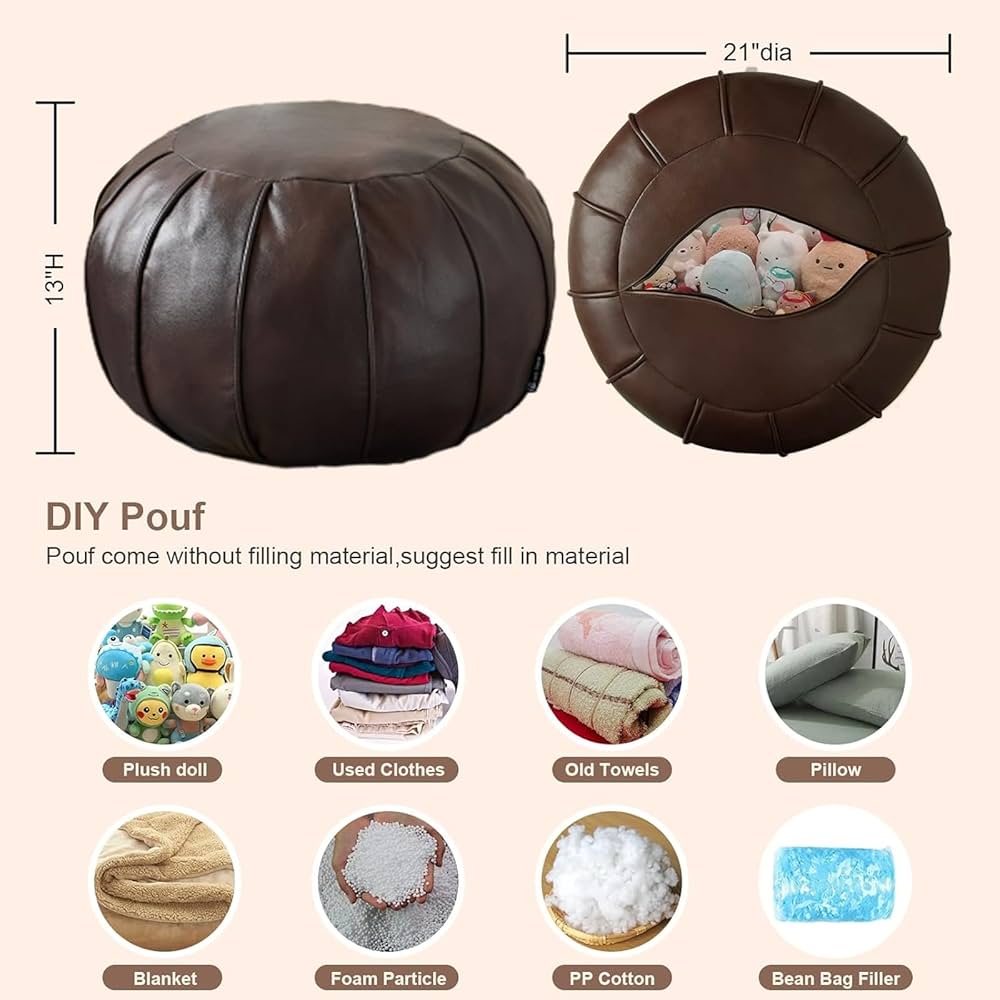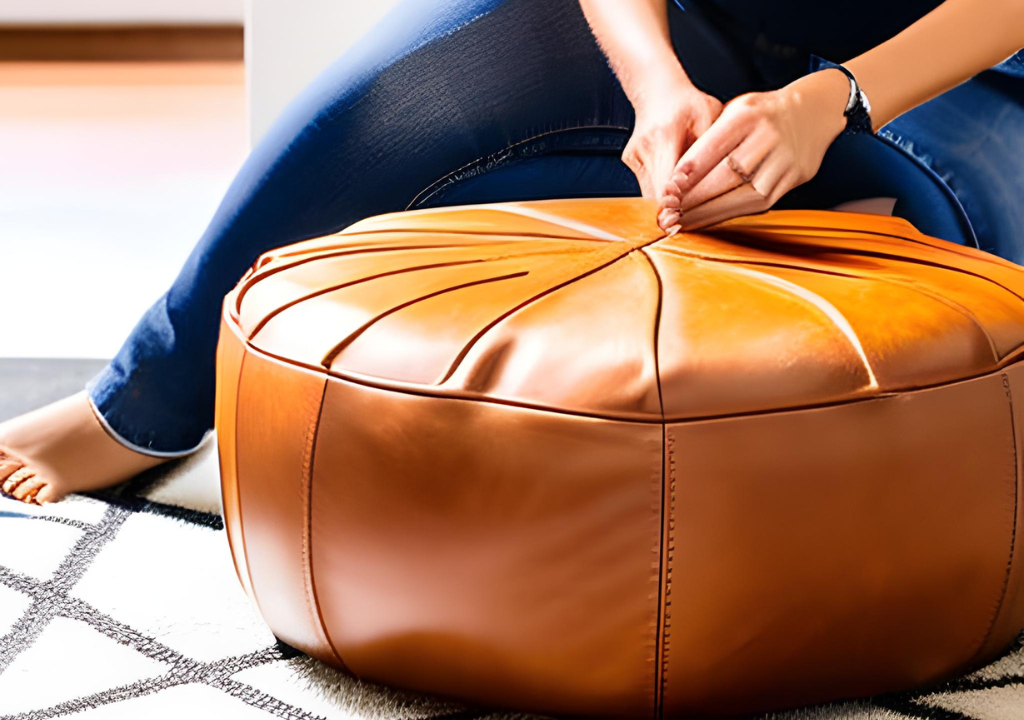Are you ready to transform your living space with a Moroccan pouf but unsure what to fill it with? Choosing the right filling can make all the difference in comfort, durability, and style.
Whether you want a pouf that’s soft and cozy or firm and supportive, the filling you pick will shape your experience every time you sit down. Keep reading, and you’ll discover simple, affordable options that suit your needs perfectly. Your perfect pouf is just a few steps away!

Credit: waysouk.com
Types Of Fillings For Moroccan Poufs
Choosing the right filling for a Moroccan pouf affects its comfort and shape. Different fillings offer unique benefits. Some maintain tradition, while others suit modern needs or focus on eco-friendliness. Understanding these options helps pick the best pouf for your space.
Traditional Fillings
Traditional Moroccan poufs often use natural materials. One common filling is sheep’s wool. It offers softness and good support. Another popular choice is cotton, which is breathable and lightweight. Some poufs are filled with horsehair for a firm feel. These materials give an authentic look and feel. They are durable and long-lasting but may need occasional fluffing.
Modern Alternatives
Modern poufs often use synthetic fillings. Polyester fiberfill is common because it is soft and affordable. Foam beads or shredded memory foam provide extra cushioning. These fillings keep the pouf’s shape well. They are lightweight and easy to clean. Some modern poufs mix foam with fiberfill for balance. These options suit busy homes needing low maintenance.
Eco-friendly Options
Eco-friendly fillings are gaining popularity. Recycled polyester is one such option. It reduces waste and stays comfortable. Natural buckwheat hulls offer firm support and good airflow. Coconut coir is another sustainable choice, giving a natural texture. These materials are biodegradable and safe for the environment. They work well for people who prefer green living.
Choosing The Right Filling For Comfort
Choosing the right filling for your Moroccan pouf is key to creating a comfortable and inviting piece in your home. The filling affects not only how the pouf feels but also how long it lasts and how well it fits your lifestyle. Think about what kind of comfort you want: soft and cozy or firm and supportive.
Soft Vs Firm Fillings
Soft fillings like down feathers or shredded memory foam offer a plush, sink-in feel that’s perfect for relaxation. If you enjoy curling up with a book or need extra cushioning for your feet, these might be your best choice.
On the other hand, firm fillings such as dense foam or tightly packed polyester provide solid support, making the pouf suitable for seating or as a stable footrest. Do you prefer a pouf that holds its shape or one that molds to your body? Your answer will guide your filling choice.
Allergy Considerations
Some fillings like natural feathers or wool can trigger allergies, causing discomfort or sneezing fits. If you or your guests have sensitivities, hypoallergenic options like polyester fiberfill or synthetic foam are safer bets.
Consider how easy it is to clean the filling too. Synthetic materials often resist dust mites and mold better, keeping your pouf fresh for longer.
Durability And Support
Durability depends heavily on the filling material. High-density foam and shredded leather tend to maintain their shape over time, offering consistent support even with frequent use.
If your pouf will get a lot of daily use, prioritize fillings that resist flattening and wear. Would you rather replace the filling occasionally or invest upfront in something longer-lasting?
Filling Materials And Style Impact
The filling material inside a Moroccan pouf greatly influences its look and feel. The choice changes the pouf’s firmness, shape, and overall style. Selecting the right filling helps keep the pouf comfortable and visually appealing.
How Fillings Affect Shape
Different fillings create distinct shapes and firmness levels. Firmer materials keep the pouf well-shaped and supportive. Softer fillings allow the pouf to mold to the body but may lose shape quickly.
- Foam:Holds shape well and feels firm.
- Polyester Fiberfill:Soft and fluffy, less structured.
- Bean Bag Beads:Moldable but can shift inside.
- Old Clothes or Fabric Scraps:Eco-friendly but uneven shape.
Maintaining Pouf Aesthetics
Maintaining the pouf’s look means choosing fillings that retain volume and firmness. Regular fluffing can help keep a soft filling from flattening. For firm fillings, occasional reshaping is important to avoid lumps and sagging.
Consider using a liner inside the pouf cover to hold fillings in place. This stops shifting and helps the pouf look fresh longer.
Matching Fillings With Décor
The filling type impacts the pouf’s style and how it fits into a room. Firm poufs suit modern or minimalist décor. Softer poufs work well in casual or bohemian spaces.
Think about the room’s function. A firm pouf makes a good seat. A soft pouf works better as a footrest or decorative piece.

Credit: www.amazon.ca
Diy Filling Tips And Tricks
Filling a Moroccan pouf at home can be fun and rewarding. It lets you control the comfort and shape of your pouf. Using the right materials and techniques helps the pouf last longer and feel better. Follow simple tips to prepare and fill your pouf effectively.
Preparing Your Pouf
Start with a clean, empty pouf cover. Check for any holes or weak spots. Repair these before filling. Choose a well-ventilated space to work in. Gather all your filling materials and tools. This makes the process smooth and easy.
Filling Techniques
Use lightweight materials like polyester fiberfill for softness. Add old clothes or fabric scraps for firmness. Mix different fillings to balance comfort and shape. Use a funnel or a rolled paper to guide small pieces inside. Fill the pouf evenly to avoid lumps. Press and shape the pouf as you fill it. Stop filling when it feels firm but still soft.
Common Mistakes To Avoid
- Overfilling can make the pouf hard and uncomfortable.
- Underfilling causes the pouf to lose shape quickly.
- Ignoring weak seams can cause tearing later.
- Using heavy materials may make the pouf hard to move.
- Not distributing filling evenly leads to lumps and bumps.
Where To Buy Filling Materials
Finding the right filling materials for your Moroccan pouf is easy with many options available. Choosing the best place to buy depends on your needs, budget, and convenience. Various stores and websites offer quality filling materials that fit different pouf sizes and styles.
Check local stores for quick access and personal advice. Online sources provide variety and delivery options. Budget-friendly picks help save money without sacrificing quality. Explore these options to get the perfect filling for your pouf.
Local Stores
Local stores often carry filling materials like foam, cotton, and polyester. Craft shops and fabric stores usually stock stuffing options suitable for poufs. Visiting a store lets you feel the material before buying. Staff can offer helpful tips on what works best. Local stores are great for small or urgent purchases.
Online Sources
Online shops offer a wide range of filling materials for Moroccan poufs. Websites like Amazon, Etsy, and specialty craft sites have many choices. You can read reviews to find trusted products. Online buying saves time and delivers straight to your door. Look for sellers with good ratings for the best results.
Budget-friendly Picks
Budget-friendly filling materials are easy to find. Recycled fabrics and shredded foam often cost less. Some stores sell leftover stuffing by weight at discounted prices. Buying in bulk can also reduce costs. Choose budget options that still provide comfort and durability for your pouf.
Maintaining And Refilling Moroccan Poufs
Natural fillers like cotton, wool, or polyester fiberfill work well for Moroccan poufs. Small foam pieces or recycled fabric scraps provide firm support and shape. Choose soft, lightweight materials to keep the pouf comfortable and easy to maintain.
Maintaining and Refilling Moroccan Poufs Moroccan poufs are not just stylish additions to your home; they offer versatility and comfort that few other pieces can match. Whether you’re using yours as a footrest, extra seating, or even a coffee table, keeping it in top shape is essential. By understanding when and how to refill your pouf, you can extend its life and maintain its appeal.When To Refill
Knowing when to refill your Moroccan pouf can make a significant difference in its longevity and comfort. If you notice that your pouf is sagging more than usual or feels less supportive, it might be time for a refill. Regularly check the firmness to ensure it meets your comfort needs.Cleaning Fillings
Keeping the fillings clean is crucial for maintaining your pouf’s hygiene. Depending on what you use to fill your pouf, you might need to wash or replace the stuffing periodically. Ensure that any fabric or material you use can be easily cleaned or replaced, like old clothes or shredded foam.Extending Pouf Life
To make your pouf last longer, consider the environment where it’s placed. Avoid direct sunlight, which can cause the fabric to fade and weaken over time. Additionally, rotate the pouf regularly to ensure even wear and tear, maintaining its structure and appearance for years to come.
Credit: kechart.com
Frequently Asked Questions
What Materials Are Best To Fill A Moroccan Pouf?
Common fillings include polyester fiberfill, foam pieces, and old clothes. These materials provide comfort and help the pouf retain shape.
Can I Use Recycled Materials To Stuff A Moroccan Pouf?
Yes, using recycled fabrics or clothes is eco-friendly and cost-effective. Ensure the materials are clean and soft for comfort.
How Much Filling Is Needed For A Moroccan Pouf?
Fill the pouf tightly but leave some room to maintain softness. Typically, 3 to 5 pounds of filling works well.
Is Foam Better Than Fiberfill For Moroccan Poufs?
Foam offers firmer support and durability. Fiberfill feels softer but may compress faster. Choose based on desired comfort and usage.
Conclusion
Choosing the right filling makes your Moroccan pouf comfy and long-lasting. Common options include foam, cotton, or old clothes. Each filling changes the pouf’s feel and weight. Consider how you will use the pouf daily. Soft fillings work well for resting feet.
Firmer fillings help with sitting support. Easy-to-find materials keep costs low. Filling your pouf yourself can be fun and satisfying. Enjoy a cozy, stylish addition to your home with the perfect fill.





